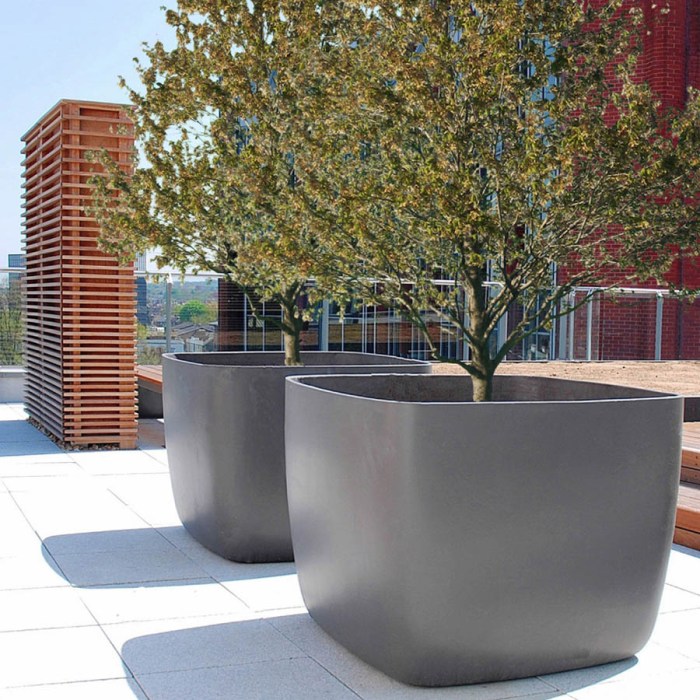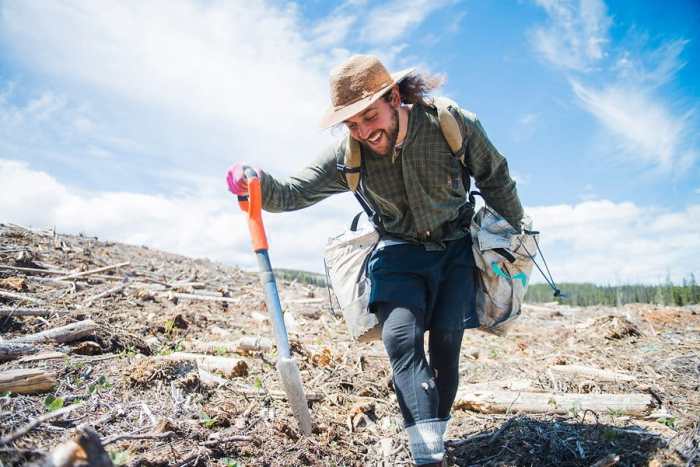Auger to Plant Trees A Comprehensive Guide
Soil Considerations and Auger Effectiveness

Auger to plant trees – Yo, Jogja peeps! Planting trees is rad, but getting those saplings in the ground smoothly? That’s where the auger comes in. But hold up, the soil’s got a lot to say about how well this whole operation goes down. Let’s dive into how different soil types can impact your tree-planting game.
Soil type and condition massively affect auger performance and, more importantly, your tree’s chances of survival. Think of it like this: trying to drill through granite with a butter knife versus a power drill – one’s gonna be a whole lot easier (and less likely to damage the “butter”). The right tool for the job is key, and that includes understanding your soil.
Auger Performance in Various Soil Types
Different soils present unique challenges. Sandy soils are generally easier to auger through, offering less resistance. Clay soils, on the other hand, can be incredibly sticky and difficult, often requiring more powerful augers or even alternative methods. Rocky soils? Forget about it unless you’ve got a seriously robust auger – you might even need to break out the pickaxe first.
Each soil type affects the auger’s ability to create a clean, consistent hole, which is crucial for proper root development and tree establishment.
Challenges and Solutions for Auger Use in Different Soil Types, Auger to plant trees
Let’s get real: augers aren’t magic wands. Here’s a breakdown of common problems and how to tackle them:
| Soil Type | Challenges | Solutions/Alternatives | Auger Recommendations |
|---|---|---|---|
| Sandy Soil | Holes may collapse easily; auger bit might slip. | Use a slightly wider auger bit to create more stable holes; consider adding soil amendments to improve soil structure. | Standard auger with a sharp bit; possibly a slightly wider diameter than usual. |
| Clay Soil | High resistance; auger bit can get clogged; holes can be compacted. | Use a powerful auger with a self-cleaning bit; pre-soak the soil if possible; avoid compacting the soil after drilling. | Heavy-duty auger with a spiral or flight auger bit; consider a hydraulic auger for particularly tough clay. |
| Rocky Soil | Auger bit can break or become damaged; difficult to create consistent holes. | Use a rock auger bit or a specialized auger designed for rocky conditions; manually remove large rocks before augering; consider hand-digging in extremely rocky areas. | Rock auger with carbide or hardened steel tips; a smaller diameter auger might be more maneuverable. |
| Loamy Soil (Ideal) | Generally easy to work with; minimal challenges. | Maintain soil moisture levels; ensure the auger bit is sharp. | Standard auger with a sharp bit. |
Selecting the Appropriate Auger for Specific Soil Conditions
Choosing the right auger is like picking the perfect surfboard – you need one that matches the conditions. A lightweight auger might work great in sandy soil, but it’ll struggle in clay. Consider the soil’s composition, moisture content, and the size of the trees you’re planting when selecting your auger.
Yo, using an auger to plant trees is way easier, especially for those smaller saplings. Planting a whole bunch? Makes the job super smooth. If you’re thinking about something specific, like a small rubber tree plant , the auger’s gonna be your best friend. Just make sure the hole’s deep enough, then you’re good to go.
Makes planting a breeze, you know?
Auger Maintenance and Safety: Auger To Plant Trees

Yo, Jogja’s green thumbs! Planting trees with an auger is rad, but keeping your equipment in tip-top shape and staying safe is crucial. Think of it like this: a well-maintained auger is your secret weapon for a thriving forest, and safety practices are your shield against any mishaps. Let’s dive into the nitty-gritty of auger care and safety protocols.
Regular maintenance and adherence to safety guidelines are paramount for extending the lifespan of your auger and preventing injuries. Neglecting either aspect can lead to costly repairs, downtime, and potential harm. Remember, a little preventative care goes a long way!
Auger Maintenance Schedule
Maintaining your auger is key to its longevity and efficient operation. A consistent maintenance schedule will ensure your auger performs optimally and prevents unexpected breakdowns during crucial planting periods. This schedule focuses on preventative maintenance, keeping your auger running smoothly.
- Daily Cleaning: After each use, remove all soil, debris, and plant material from the auger’s shaft, flighting, and bit. Use a stiff brush and compressed air to remove stubborn dirt. Wipe down all metal surfaces with a clean rag to prevent rust.
- Weekly Lubrication: Apply a high-quality grease to all moving parts, including bearings and gearboxes. This reduces friction and wear, prolonging the life of your auger. Focus on areas where metal parts rub against each other.
- Monthly Inspection: Carefully inspect the auger for any signs of damage, such as bent shafts, cracked flighting, or worn bits. Check for loose bolts and nuts, tightening them as needed. This proactive approach prevents minor issues from escalating into major problems.
- Annual Sharpening: If your auger bit is showing signs of dullness, have it professionally sharpened. A sharp bit ensures clean, efficient hole drilling, reducing the effort required and preventing damage to the auger. Dull bits can also lead to uneven holes, impacting tree survival.
Safety Guidelines for Auger Operation
Operating an auger safely requires careful attention and adherence to specific procedures. Ignoring safety protocols can lead to serious injuries or equipment damage. Prioritize safety above all else!
- Always wear appropriate personal protective equipment (PPE): This includes safety glasses or goggles to protect your eyes from flying debris, work gloves to prevent cuts and abrasions, and sturdy work boots to protect your feet. Consider hearing protection if operating a powerful auger.
- Ensure the area is clear of obstructions: Before operating the auger, thoroughly inspect the work area to remove any rocks, roots, or other obstacles that could damage the auger or cause it to malfunction. Clear a safe working radius around the auger.
- Maintain a firm grip on the auger and use proper posture: Avoid reaching or overextending while operating the auger, which could lead to loss of control and potential injuries. Keep a balanced stance and maintain a firm grip on the handles.
- Never operate the auger near power lines or underground utilities: Contact your local utility company to locate underground lines before commencing any work. Striking a power line can be fatal.
- Never leave the auger unattended while running: Always turn off the auger and remove the key before leaving it unattended, even for short periods. This prevents accidental starts and potential injuries.
- Follow the manufacturer’s instructions carefully: Familiarize yourself with the auger’s operation manual before using it. This will help you understand the proper techniques and safety procedures for your specific model.
Potential Risks and Mitigation Strategies
Understanding the potential risks associated with auger operation is vital for effective risk mitigation. Proactive measures significantly reduce the likelihood of accidents and injuries.
- Risk: Striking rocks or other hard objects can damage the auger bit or cause the auger to kick back, potentially injuring the operator. Mitigation: Carefully inspect the soil before drilling and use a metal detector if necessary to identify buried objects. Operate the auger slowly and cautiously.
- Risk: Getting entangled in the auger’s rotating parts can cause severe injuries. Mitigation: Maintain a safe distance from the rotating parts of the auger at all times. Never reach into the auger while it is running.
- Risk: Improper lifting techniques can lead to back injuries. Mitigation: Use proper lifting techniques, avoid overexertion, and consider using mechanical lifting aids for heavier augers.
- Risk: Exposure to hazardous materials in the soil, such as chemicals or contaminated soil, can pose health risks. Mitigation: Wear appropriate PPE, including gloves and respirators, when working in potentially contaminated areas. Follow relevant safety regulations and guidelines.
FAQ Corner
What is the lifespan of a tree planting auger?
The lifespan depends on usage, maintenance, and soil conditions. With proper care, a high-quality auger can last for many years.
Can I use an auger to plant larger trees?
Larger augers are available for bigger trees, but hand-digging might be more suitable for extremely large specimens.
How do I sharpen a tree planting auger?
Use a file or grinder specifically designed for auger bits. Follow manufacturer’s instructions for sharpening angles.
What are the signs of auger damage that require repair or replacement?
Bent shafts, chipped or broken auger bits, and excessive wear are indicators needing attention.
